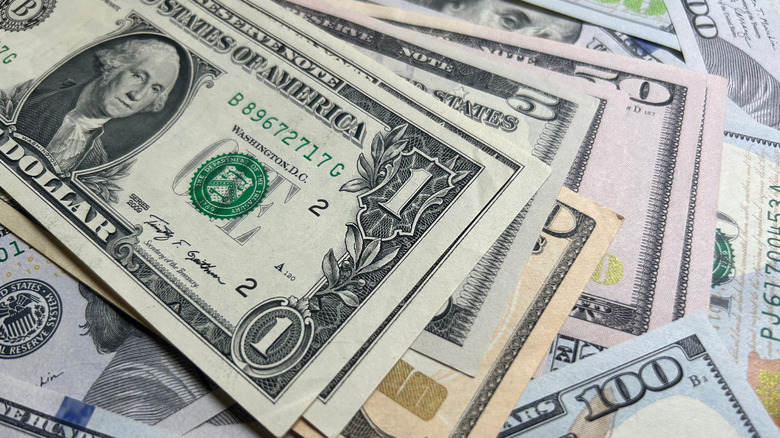The 'Bill Series' On A $1 Bill Doesn't Mean What You Think It Does
Plenty of hidden symbols exist on paper currency, with many of them interwoven into the bills' designs so that counterfeit bills can be more easily identified. A bill series number, though, is more overlooked than hidden. To identify a bill series, examine the photo above or a bill from your wallet. On a $1 bill, between George Washington's image in the center and the secretary of the treasury's signature, you should see the word "Series" listed above a year. That's the bill series. Common sense might suggest that the bill was printed that year, since dates on coins typically indicate when the mint struck them — though there are exceptions — but a bill series is a different story.
Dates on paper currency actually indicate when its design was implemented, not when the bill was printed. The printed date then remains static — often for years — until a significant design change occurs, such as when a new secretary of the treasury is sworn in. Sometimes, you'll also see a letter printed in addition to the year, which denotes that a smaller design change had also occurred.
The reason a letter might get added to a bill series
Unlike the explanation for why U.S. currency is green, gaining clarity over why a letter was added to a bill series can be challenging, as the Bureau of Engraving and Printing (BEP) is often reluctant to disclose specifics. For example, in 2020, Coin World referenced a potential production process change described in a Treasury Department's Office of the Inspector General report. The Treasury Department had briefly mentioned a December 2013 development in ink solvents that, in November 2015, received approval for usage in currency. Capabilities of this ink solvent could facilitate an ink change which, if implemented, could trigger the addition of a letter to the bill series.
Currency bill series numbers changed to 2017 after Treasury Secretary Steven Terner Mnuchin replaced Jacob Joseph Lew. Then, by July 2020, the 2017 bill series denominations changed to 2017A. Curious about the change, Coin World asked the BEP whether this advancement in ink solvent and alteration in ink were the reasons for this change. When responding, the BEP's Lead Public Affairs Specialist Lydia J. Washington didn't confirm or deny this trigger. Instead, she referenced security issues that prevented her from describing what changed. She did, however, say that the A referenced a discretionary change in materials or processes that didn't alter the "form, fit, or function" of the bills at a detectable level — in other words, a minor change.

